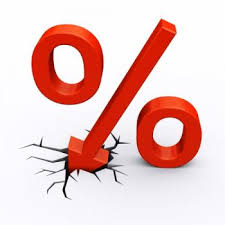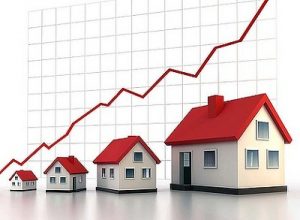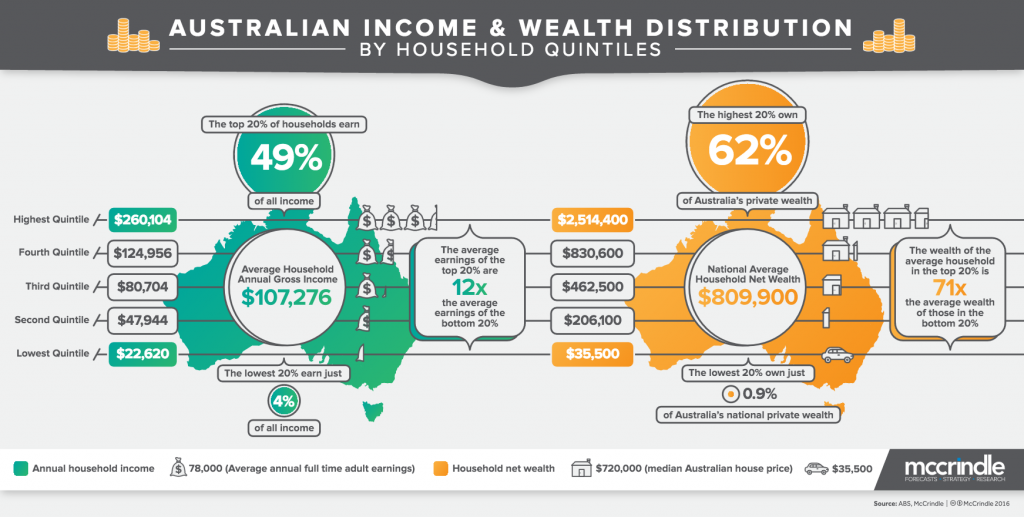Are Low Interest Rates Destroying Australia’s Middle Class?
 The Reserve Bank of Australia (RBA) just cut the cash rate to an unprecedented low of 1.50 percent. Glenn Stevens also hinted in his monetary policy statement that further easing is likely. Even now, traders are pricing in a 50/50 chance of another rate cut in November.
The Reserve Bank of Australia (RBA) just cut the cash rate to an unprecedented low of 1.50 percent. Glenn Stevens also hinted in his monetary policy statement that further easing is likely. Even now, traders are pricing in a 50/50 chance of another rate cut in November.
Should we see this as welcome news?
Property investors and homebuyers tend to think only about the short-term cash-flow benefit of low interest rates, but fail to consider the long-term negative impact on the economy. When the RBA cut the cash rate from 2.50 to 2.25 percent in early 2015, I shared “5 Reasons Artificially Low Interest Rates Suck Long-Term.”
But here’s one I failed to mention: low interest rates tend to expand the wealth gap between the rich and the poor.
Are we really a classless society?
Australians have long held to the egalitarian ideal of maintaining a classless society. We’re a nation where a banker and a plumber can meet in a pub, drink a few beers together, talk footy, and then go their separate ways oblivious to the snobbery that permeates much of the western world.
While Australians may still consider themselves above class, a recent report from the social research group McCrindle says economically, we’re far from equals. The gap between the rich and the poor keeps getting wider. You can see for yourself in the following infographic.
Click on the image to enlarge it or download the PDF here. Or just keep reading for the highlights…
The green map on the left represents annual household income. Here’s what it reveals:
- The top 20 percent of households earn 49 percent of all income.
- The lowest 20 percent earn only 4 percent of all income.
- The average earnings of the top 20 percent are 12 times greater than the average earnings of the bottom 20 percent.
The orange map on the right represents household net worth. These figures show an even wider gap:
- The top 20 percent own 62 percent of Australia’s private wealth.
- The lowest 20 percent own a measly 0.9 percent of Australia’s private wealth.
- The wealth of the average household in the top 20 percent is 71 times that of the average wealth of those in the bottom 20 percent.
A report from Oxfam Australia paints a similar, but more detailed picture:
- The richest 10 percent of Australians owns more wealth than the remaining 90 percent combined.
- Of all the additional wealth accrued by Australians since 2000, the richest 10 percent captured more than half, while the poorest 10 percent captured so little of this extra wealth that their share is almost zero.
- The richest 1 percent of Australians own more wealth than the poorest 60 percent.
In summary, the rich are getting richer, the poor are getting poorer, and the middle class is getting smaller. This is not a healthy trend and does not bode well for our future.
According to research by the National Centre for Social and Economic Modelling, Australia’s wealth gap grew by 13 percent over the past decade and is projected to widen by a further 10 percent over the next 10 years.
What’s the cause?
 So what has caused this great divide? Why are the wealthy getting wealthier and the poor spinning their wheels?
So what has caused this great divide? Why are the wealthy getting wealthier and the poor spinning their wheels?
The truth is, there will always be those who have more vision, greater talents and skill, and a stronger work ethic. These people will prosper more than others. In a free market, keeping everyone on the same economic rung is impossible. It’s also immoral, would be a disincentive, and would amount to an injustice to those who are creative and hard working.
However, we should also be aware of the impact that our nation’s monetary policies can have on those who don’t yet own assets, and the knock-on effect this can have in the broader economy.
The primary cause of this great wealth divide is simply that the top 20 percent has owned real estate and the bottom 20 percent has not. It’s no secret that the majority of Aussie wealth is tied up in land and buildings.
Why has real estate increased so dramatically in value? While we can point to multiple factors, like population growth concentrated around capital cities and tax incentives for property investors, the ultimate reason is the availability of cheap credit.
Interest rates have been on the decline in Australia for the better part of the last decade, and few people believe they’ll be going back up any time soon. The result has been ever-increasing home prices as homebuyers have upped their standard of living and property investors have speculated on capital growth.
Sydney home prices are up 5.6 percent since the RBA’s last rate cut in May, and the median house price there is now back above $1 million. Melbourne’s median house price has surged to a new record of over $740,995.
The financial comparison website Finder recently forecasted that if current trends continue, Melbourne median home prices could skyrocket past $6 million by 2050. That would amount to a home price to income ratio of more than 17 to one.
And you thought first homebuyers were having a difficult time today.
Pressure is already mounting from the have-nots, as they call upon our political leaders to do something to stop the growth of home prices. Labor is still lobbying to change tax concession legislation and Turnbull is suggesting parents pony up some cash to help their kids buy a house.
 Glenn Stevens himself hinted a few months ago that he wants investors to cool off:
Glenn Stevens himself hinted a few months ago that he wants investors to cool off:
“I think the assumption that there’s an easy road to riches through leveraged holdings of real estate… is not a great strategy and prices can fall.”
Low interest rates do not reward the creative and hard working. Those people will find a way to prosper. Low interest rates instead tend to promote malinvestment; the allocation of capital toward inefficient assets. Current central bank policy is rewarding those who take uncalculated risks, speculating on perpetual capital growth.
As property investors, what we ultimately want is not growth at all costs in the real estate market, but sustainable growth. If our nation’s household debt, already the highest in the world, continues to grow at an unsustainable level, then we not only risk a debt crisis once interest rates finally do rise, but an ever-widening gap between the rich and the poor.
A shrinking middle class has never been healthy for any nation, as it creates greater conflict between the haves and the have-nots. We’re already beginning to see some early signs of class warfare as Labor is acting as the champion of the disenfranchised and the Liberals are representing the top 20 percent seeking to preserve their wealth.
Only time will tell how low interest rates ultimately will go in Australia, but if Japan, Europe, and the United States are an indication, we’re far from seeing the bottom. Let’s hope our central bankers and leaders in Canberra decide not to sell out future generations for the sake of immediate gain and political expediency.
What do you think?
How low will interest rates go?
What’s the next move you believe our central bankers should make?
Are you concerned about the growing wealth divide?
Comments
Got something to say? Post a comment...
You must be logged in to post a comment.






This is insightful – thanks.
What I would really enjoy is if investors in Australia took the cheaper cash used it to focus on angel investment and venture capital. It seems like it would be so much more productive. The higher rates for investment properties goes some way towards providing a market signal, but it doesn’t seem like enough. There is so much ‘investment momentum’ in property.
I’m interested to see if you or Steve have any thoughts on this.
Thanks for your comment Rene. Yes, I agree with you. Investing in businesses that will grow the economy and actually employ people is a much more productive use of debt than to speculate on an inefficient asset like real estate. I expect APRA to try to shift this flow of capital away from real estate into small business.
Yep I agree.
There was absolutely ZERO reason for the recent RBA rate cut.
I’ve given up believing the govt figures when it comes to inflation. Basically asset inflation is out of control and whilst APRA lending restrictions are helping somewhat…..it doesn’t bode well for Australia’s future.
It is surprising how the RBA thinks that we can do what Japan, Europe, and the USA have been unable to do (stimulate growth by devaluing the currency). I wonder how far Glenn’s protege will take this little monetary experiment.
Thank you Jason for your market insights, they are always a brilliant read. Hope the family is well and your enjoying Melbourne.
Thanks Matt. Hope all is well with you. Hope to see you at our next Workshop in September.